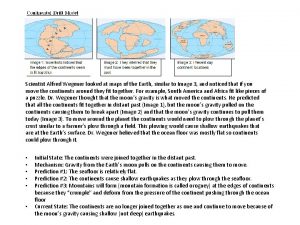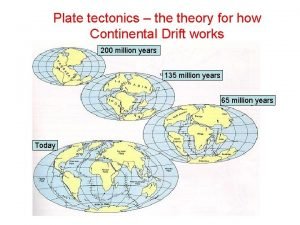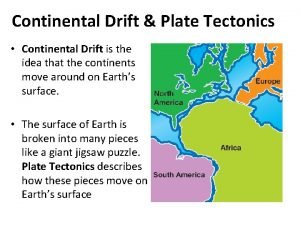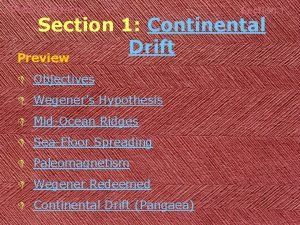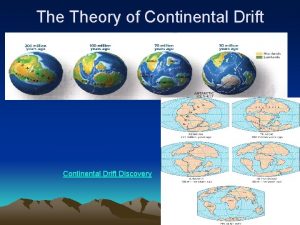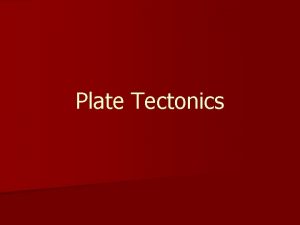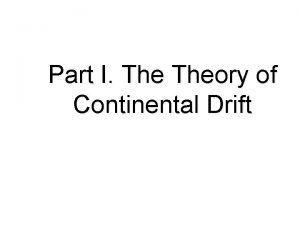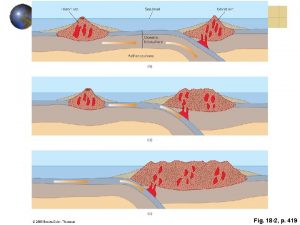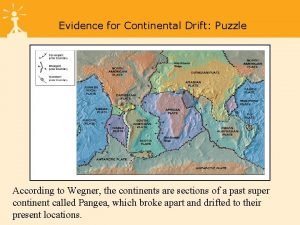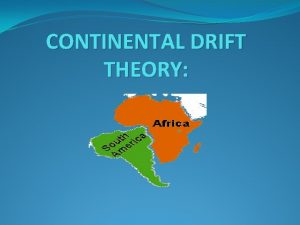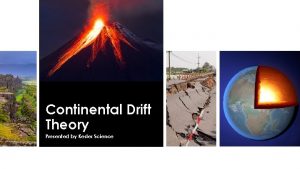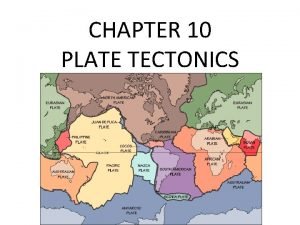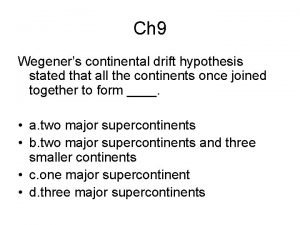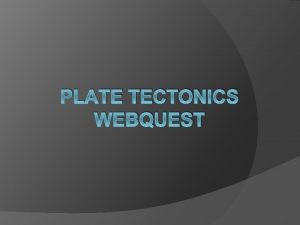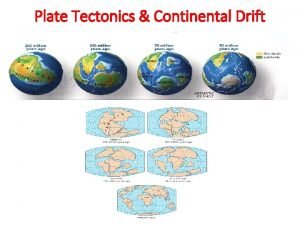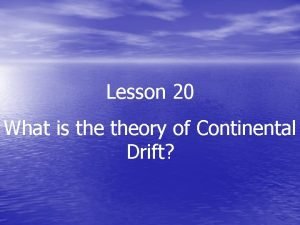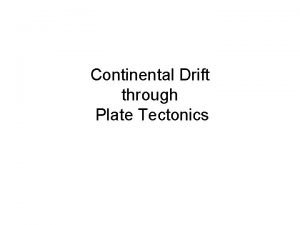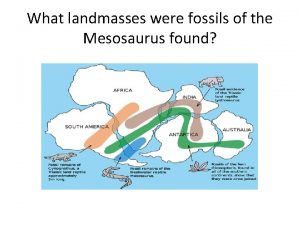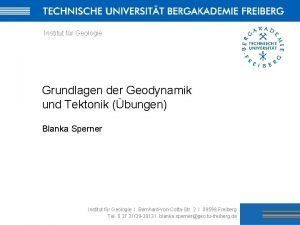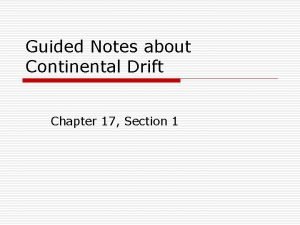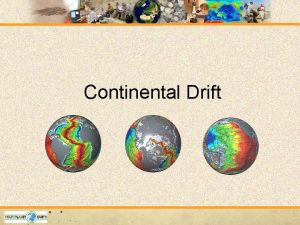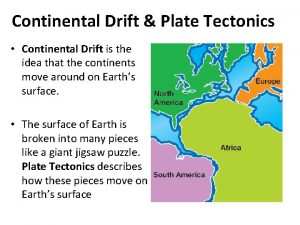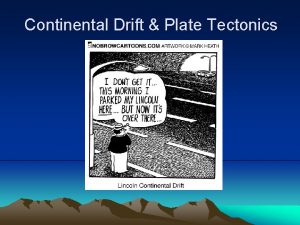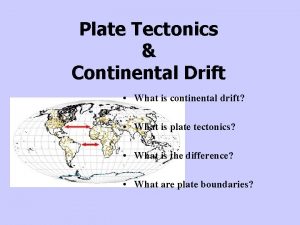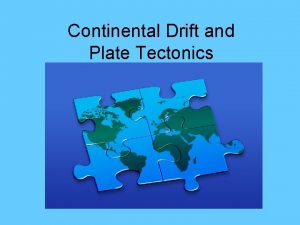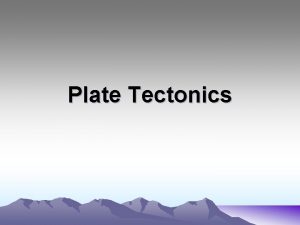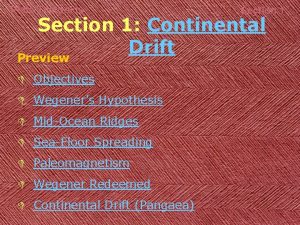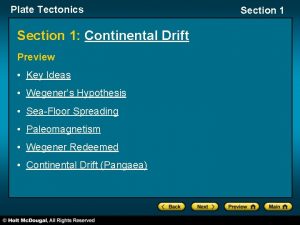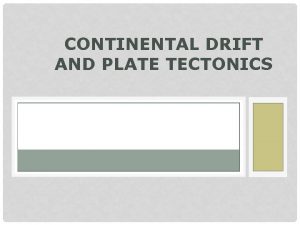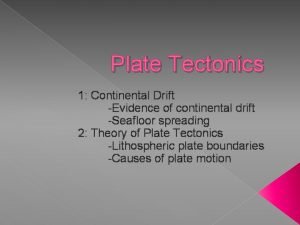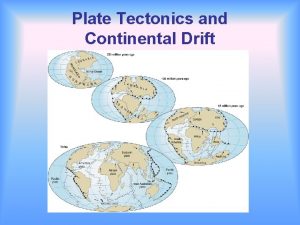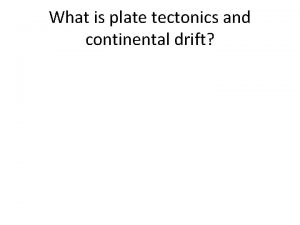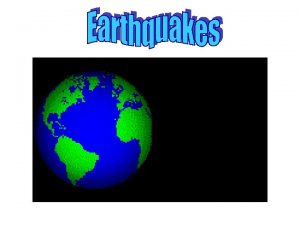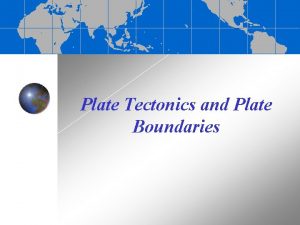Plate Tectonics Section 1 Continental Drift Preview D




























- Slides: 28

Plate Tectonics Section 1: Continental Drift Preview D Objectives D Wegener’s Hypothesis D Mid-Ocean Ridges D Sea-Floor Spreading D Paleomagnetism D Wegener Redeemed D Continental Drift (Pangaea)

Plate Tectonics Section 1 Objectives D Summarize Wegener’s hypothesis of continental drift. D Describe the process of sea-floor spreading. D Identify how paleomagnetism provides support for the idea of sea-floor spreading. D Explain how sea-floor spreading provides a mechanism for continental drift.

Plate Tectonics Section 1 Wegener’s Hypothesis D Continental drift the hypothesis that states that the continents once formed a single landmass, broke up, and drifted to their present location. D The hypothesis of continental drift was first proposed by German scientist Alfred Wegener in 1912. D Wegener used several different types of evidence to support his hypothesis.

Plate Tectonics Section 1 Wegener’s Hypothesis, continued Wegener’s Evidence D Fossil Evidence: fossils of the same plants and animals could be found in areas of continents that had once been connected. D (2 types): C Lystrosaurus: a hippo like fossil found on 3 continents far apart. This animal “swam” by walking along the bottom of areas of surface water, but because this animal needed to breathe oxygen it had to be able to get to the surface to breathe, so it couldn’t cross very deep bodies of water such as those that separated the 3 continents it was found on.

Plate Tectonics Section 1 Evidence, cont. 2. Glossopteris: a tropical fern-like fossil found on 5 continents- it backed up continental drift in 2 ways: D It was a tropical fossil found on Antarctica – so that continent must’ve been somewhere warmer once. D The fern reproduced using a kind of spore that was to heavy to blow long distances, and that would have become dehydrated and rotted if it floated in the ocean water to long. It also was found on 3 different continents very far apart.

Plate Tectonics Section 1 Evidence, cont. D Evidence from Rock Formations: ages and types of rocks in the coastal regions of widely separated areas matched closely. C Evidence from Rock Formations: ages and types of rocks in the coastal regions of widely separated areas matched closely- if the rock patterns in mountain chains on 2 different continents match, they must have originally been all part of one mountain chain b/c it is impossible for 2 areas to have the exact same conditions to form identical patterns independently.

Plate Tectonics Section 1 Evidence, cont. D Climatic Evidence: changes in climatic patterns suggested the continents had not always been located where they are now. DClimatic Evidence: changes in climatic patterns suggested the continents had not always been located where they are now-fossils of tropical organisms were found on land masses that were currently in polar regions, so the land masses must have been located in a more tropical region at one point in time.

Plate Tectonics Section 1 Wegener’s Hypothesis, continued Similar rock formations and fossil evidence supported Wegener’s hypothesis.

Plate Tectonics Section 1 Wegener’s Hypothesis, continued Missing Mechanisms D Wegener proposed that the continents moved by plowing through the rock of the ocean floor. D Wegener’s ideas were strongly opposed. D Wegener’s mechanism was disproved by geologic evidence. D Wegener spent the rest of his life searching for a mechanism for the movement of continents.

Plate Tectonics Section 1 Wegener’s Hypothesis, continued Reading Check Why did many scientists reject Wegener’s hypothesis of continental drift? Many scientists rejected Wegener’s hypothesis because the mechanism that Wegener suggested was easily disproved by geologic evidence.

Plate Tectonics Section 1 Mid-Ocean Ridges D Mid-ocean ridge a long, undersea mountain chain that has a steep, narrow valley at its center, that forms as magma rises from the asthenosphere, and that creates new oceanic lithosphere (sea floor) as tectonic plates move apart

Plate Tectonics Section 1 Mid-Ocean Ridges, continued In 1947, a group of scientists set out to map the Mid-Atlantic Ridge. While studying the Mid-Atlantic Ridge, scientists noticed two surprising trends. 1. The sediment that covers the sea floor is thinner closer to a ridge than it is farther from the ridge 2. The ocean floor is very young. Rocks on land are as old as 3. 8 billion years. None of the oceanic

Plate Tectonics Section 1 Mid-Ocean Ridges, continued Rocks closer to a mid-ocean ridge are younger than rocks farther from the ridge. Rocks closer to the ridge are covered with less sediment than rocks farther from the ridge.

Plate Tectonics Section 1 Sea-Floor Spreading D Sea-floor spreading the process by which new oceanic lithosphere (sea floor) forms as magma rises to Earth’s surface and solidifies at a mid-ocean ridge D Paleomagnetism the study of the alignment of magnetic minerals in rock, specifically as it relates to the reversal of Earth’s magnetic poles; also the magnetic properties that rock acquires during formation

Plate Tectonics Section 1 Sea-Floor Spreading, continued D In the late 1950’s geologist Harry Hess proposed that the valley at the center of the mid-ocean ridge was a crack, or rift, in Earth’s crust. D As the ocean floor moves away from the ridge, molten rock, or magma, rises to fill the crack. D Hess suggested that if the sea floor is moving, the continents might be moving also. D He suggested this might be the mechanism that Wegener was searching for.

Plate Tectonics Section 1 Sea-Floor Spreading, continued As the ocean floor spreads apart, magma rises to fill the rift and then cools to form new rock.

Plate Tectonics Section 1 Sea-Floor Spreading, continued

Plate Tectonics Section 1 Sea-Floor Spreading, continued

Plate Tectonics Section 1 Sea-Floor Spreading, continued Reading Check How does new sea floor form? New sea floor forms as magma rises to fill the rift that forms when the ocean floor moves away from a mid-ocean ridge.

Plate Tectonics Section 1 Paleomagnetism D Paleomagnetism the study of the alignment of magnetic minerals in rock, specifically as it relates to the reversal of Earth’s magnetic poles; also the magnetic properties that rock acquires during formation D As magma solidifies to form rock, iron-rich minerals in the magma align with Earth’s magnetic field. When the rock hardens, the magnetic orientation of the minerals becomes permanent.

Plate Tectonics Section 1 Paleomagnetism, continued Magnetic Reversals DScientists have discovered rocks whose magnetic orientations point opposite of Earth’s current magnetic field. DRocks with magnetic fields that point north (normal polarity) are all classified in the same time periods. DRocks with magnetic fields that point south (reversed polarity) also all fell into specific time periods.

Plate Tectonics Section 1 Paleomagnetism, continued Magnetic Reversals D When scientists placed these periods of normal and reversed polarity in chronological order, they discovered a pattern of alternating normal and reversed polarity in the rocks. D Scientists used this pattern to create the geomagnetic reversal time scale.

Plate Tectonics Section 1 Paleomagnetism, continued Magnetic Symmetry D Scientists discovered a striped magnetic pattern on the ocean floor on each side of a mid-ocean ridge. D The pattern on one side of the ridge is a mirror image of the pattern on the other side. D When drawn on a map, these patterns match the geomagnetic reversal time scale.

Plate Tectonics Paleomagnetism, continued Magnetic Symmetry The pattern of magnetic symmetry and age of rock formation indicate that new rock forms at the center of a ridge and then move away from the center in opposite directions. Section 1

Plate Tectonics Section 1 Paleomagnetism, continued Reading Check How are magnetic patterns in sea-floor rock evidence of sea-floor spreading? The symmetrical magnetic patterns in sea -floor rocks show that rocks formed at one place (at a ridge) and then broke apart and moved away from the center in opposite directions.

Plate Tectonics Section 1 Wegener Redeemed D Reversal patterns on the sea floor could also be found on land. The reversals in land rocks also matched the geomagnetic reversal time scale. D Because the same pattern appears in rocks of the same ages on both land the sea floor, scientists agreed that the magnetic patterns showed change over time. D The idea of sea-floor spreading provides a way for the continents to move over the Earth’s surface. D Sea-floor spreading was the mechanism that verified Wegener’s hypothesis of continental drift.

Plate Tectonics Section 1 Continental Drift (Pangaea)

Plate Tectonics Section 1 Break-up of the continents
 Plate tectonics vs continental drift
Plate tectonics vs continental drift Continental drift
Continental drift Compare continental drift and plate tectonics
Compare continental drift and plate tectonics Convergent plate boundary
Convergent plate boundary Plate tectonics vs continental drift
Plate tectonics vs continental drift 7 lithospheric plates
7 lithospheric plates Oreo cookies plate tectonics
Oreo cookies plate tectonics Section 1 continental drift
Section 1 continental drift Continental drft
Continental drft Evidence of continental drift
Evidence of continental drift Fossil correlation continental drift
Fossil correlation continental drift Glacial evidence of pangea
Glacial evidence of pangea Continental drift puzzle
Continental drift puzzle Continental drift theory notes
Continental drift theory notes The continental drift theory
The continental drift theory Kesler science plate tectonics
Kesler science plate tectonics Fossils as evidence of continental drift
Fossils as evidence of continental drift Wegener's continental drift hypothesis stated
Wegener's continental drift hypothesis stated Continental drift simulator
Continental drift simulator Continental drift
Continental drift Plate tectonics webquest
Plate tectonics webquest Continental drift
Continental drift Wegners theory of continental drift
Wegners theory of continental drift Continental drift warm up
Continental drift warm up Continental drift and seafloor spreading worksheet answers
Continental drift and seafloor spreading worksheet answers Continental drift
Continental drift Continental drift adalah
Continental drift adalah Continental drift notes
Continental drift notes Similar fossils found on different continents
Similar fossils found on different continents


